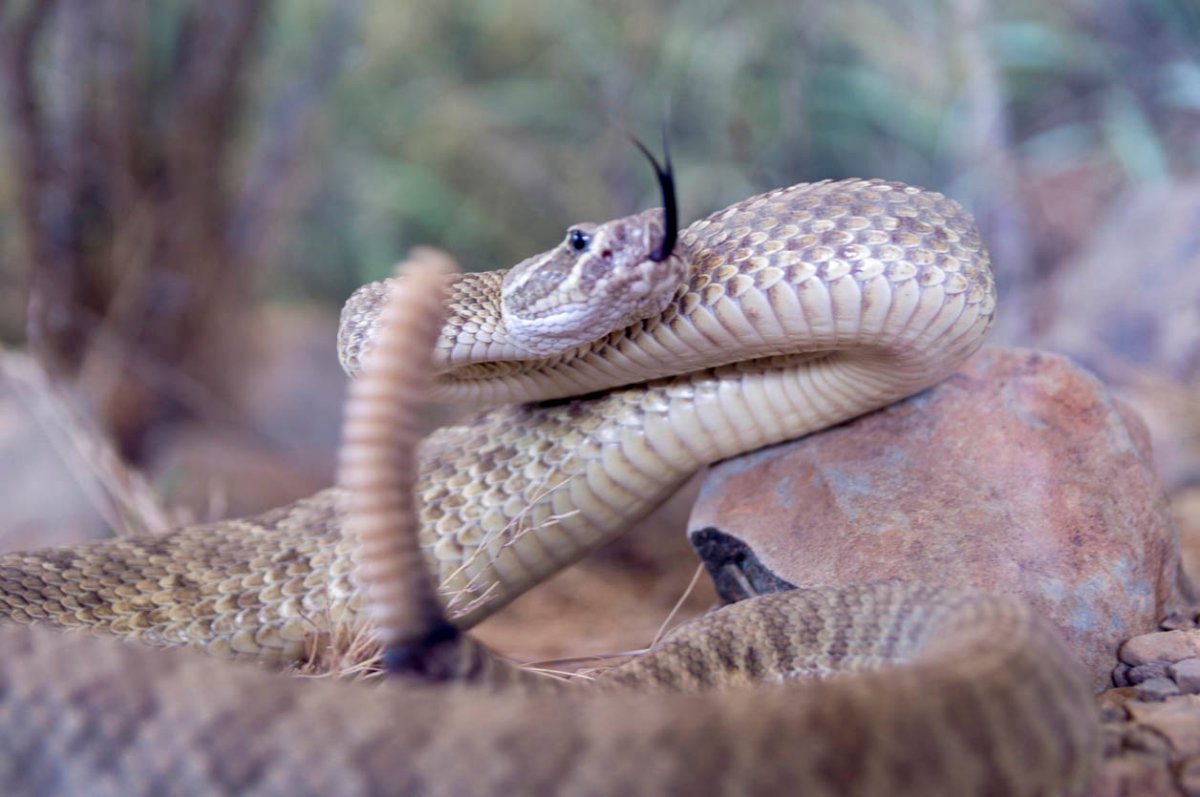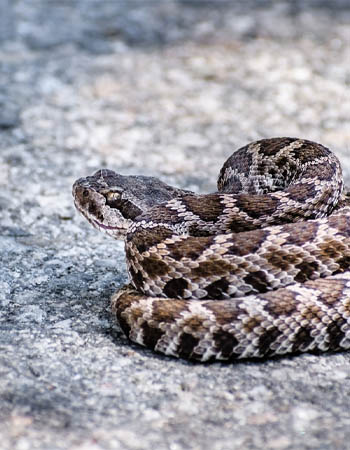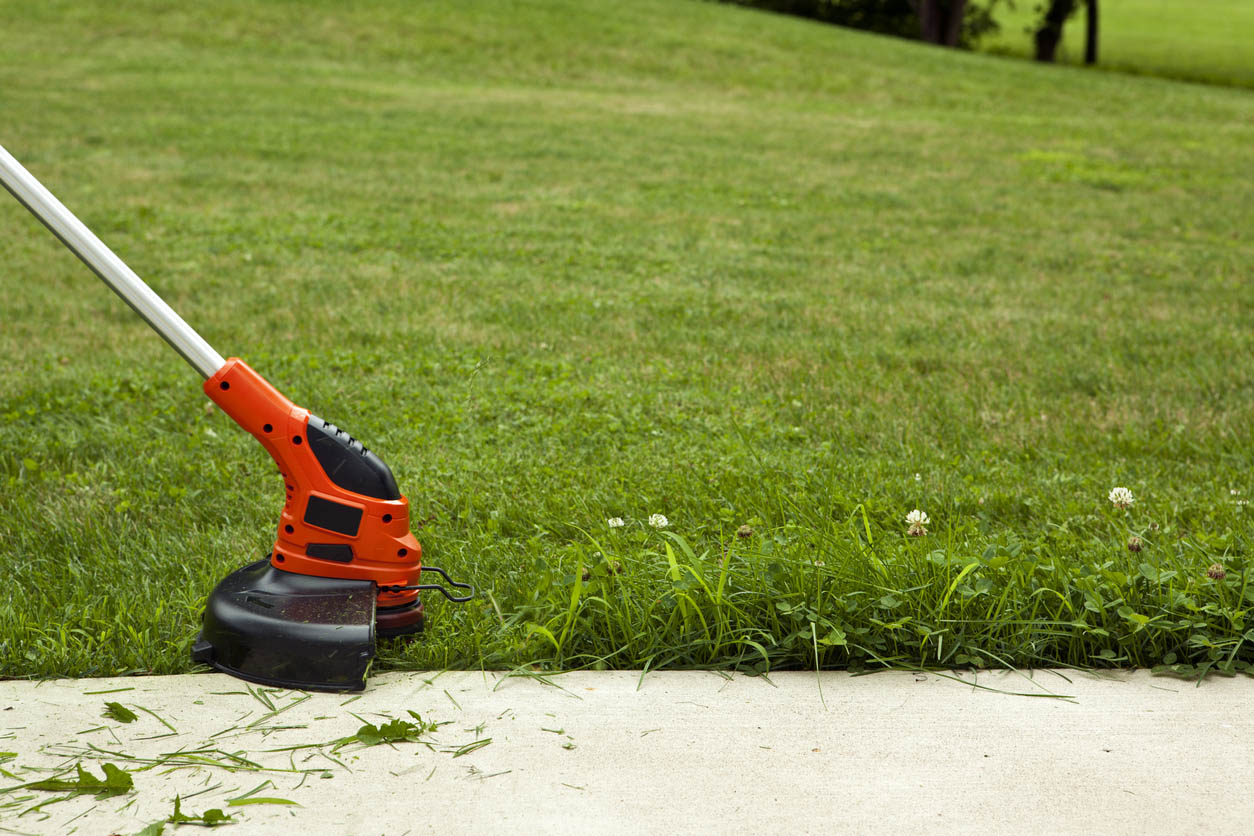

We may earn revenue from the products available on this page and participate in affiliate programs. Learn More ›
Snakes give many people the creeps, but spotting a garter or corn snake in the backyard probably isn’t cause for concern. But the presence of a rattlesnake is an issue that needs to be addressed immediately for your and your family’s safety. While rattlesnakes are most commonly found in the southwest United States, they can be found in almost every part of the 48 contiguous states.
The giveaway when identifying a rattlesnake is the rings at the base of a stubby tail. Rattlesnakes also have a wide, flat body and a triangular head shape characteristic of venomous snakes. Once you’ve identified the snake and are wondering how to get rid of rattlesnakes, there are several things you can do to remove it from your yard. However, if hands-off and preventive measures aren’t enough to keep rattlesnakes out of your yard, your best bet will be to contact an experienced wildlife management service.
Time required: 1 to 3 hours
Difficulty: Expert
Estimated cost: $100 to $500
Tools & Materials
Bobvila.com may earn a commission from purchases made through these links.
Before You Begin…

How do you get rid of rattlesnakes? Whether you need to know how to get rid of a rattlesnake den or a single rattlesnake, there is a level of danger involved. Rattlesnakes are a type of venomous viper, and getting bitten requires immediate medical attention. While most healthy adults will be able to fully recover from a rattlesnake bite with prompt, proper medical attention, untreated rattlesnake bites can be life-threatening.
If you decide to tackle this problem on your own, the steps below can help you learn how to get rid of rattlesnakes in your yard, not how to kill rattlesnakes. Rattlesnakes play an important part in controlling small mammal populations, and several species of rattlesnakes across the U.S. are endangered. That’s why when looking to get rid of rattlesnakes, it’s important to hire a professional wildlife management service that specializes in humane removal and rehoming.
Tips for Getting Rid of Rattlesnakes
- Confirm the snake is a rattlesnake by identifying specific features, including the tail and body shape.
- Clear your yard of clutter, debris, and food sources.
- Fill any open cracks, crevices, or holes in the home’s exterior.
- Set a trap or administer snake repellent.
- Contact a wildlife management service for humane removal.
Safety Considerations
- Rattlesnake bites are dangerous and can be life-threatening without treatment. It’s advised to wear long pants, a long-sleeved shirt, and other protective gear when you’re in their vicinity.
- Stay at least 10 feet away from snakes when setting rattlesnake traps or putting repellent in your yard.
- Contact a professional to remove the snake from your yard safely.
STEP 1: Identify the rattlesnake and inspect where it is active.
Most people think they would be able to identify a rattlesnake, but these creatures can look very similar to other, less-threatening snake species, like the non-venomous gopher snake.
The rattlesnake’s most prominent feature is a layered rattle at the end of its tail. This rattle makes a distinctive sound and is made of interlocked segments of keratin. From a distance, rattlesnake tails may look like blunt, stubby tails. Their bodies are flat and wide, and their skin is earth-toned. The scales form a series of diamonds or hexagons that overlap each other. Rattlesnakes also have triangular heads because of where the venom glands sit. The head shape may not be as reliable an identifier, as the heads of non-venomous garter snakes can look flat and triangular from certain angles.
Once you’ve identified the snake, it’s wise to check where it’s active so you can see if any specific conditions are attracting it. This will help you figure out where to put any traps or treatments. It’s important to pay special attention to areas with tall grass or near exterior walls, since snakes may frequent those areas the most.

STEP 2: Remove any clutter around the yard.
Areas with a lot of wood, mulch, or piles of leaves attract small mammals like rodents that are snakes’ prey. These creatures are likely attracting the rattlesnakes to your yard. So in order to get rid of rattlesnakes, you’ll need to clear out and remove any clutter that attracts their food source.
Unused planters, lawn equipment, and storage containers make good hiding places for rodents and snakes. Tall grasses or woodpiles also make convenient habitats. Snakes of all species are attracted to dark, damp conditions, so be on the lookout for areas where moisture or water could collect. These include areas in the yard with poor drainage or a leaky outdoor spigot.
Removing clutter and addressing any water issues are imperative; otherwise, the attempts you make to deter rattlesnakes could be worthless since rodents and snakes may return for these favorable conditions.
STEP 3: Eliminate any food sources.
From rodents to birds, insects, and lizards, the food that sustains rattlesnakes must be removed first to ensure the snake doesn’t continue visiting or making a permanent residence in your yard. To get rid of rodents, you can use rodenticide bait or tamper-proof bait stations, which are used to eliminate rodents altogether. Be sure to wear gloves to both protect yourself and ensure your scent doesn’t deter the rodents. Bait stations should be placed around the perimeter of your yard or along fencerows, where entrances and exits are common. The stations should be about 10 to 15 feet apart, and you’ll need to check them regularly for activity.
If you’re not sure where rodents are hiding, it’s a good idea to contact a local pest control professional to set these baits or traps. They’ll be able to identify the most effective spots around your home.
STEP 4: Trap the snake, or contact a wildlife management service to do it for you.
If you are confident in your snake-trapping skills or have prior experience to lean on, you can use a live trap to capture the snake for humane removal. Push on the door lock to open the trap and lift the door plate. It’s best to keep the door plate lifted while you pull the trigger arm forward to set it properly. Then, once the trigger arm’s hook catches on the door, your trap has been set.
If you’re not comfortable setting your own trap, it may be a good idea to contact a wildlife management service to take care of it for you. This service will know how to operate the trap, locate the best place to put it, and remove the snake once it’s captured. This may be the best option if you’re looking for solutions for how to get rid of snakes on your property.

STEP 5: Keep your lawn trimmed and the yard free from debris.
Snakes are attracted to areas with tall grass since it provides coverage and protection from potential prey such as owls or hawks. It’s best to mow your lawn frequently to reduce the number of hiding spots. Plus, shorter lawns make snakes easier to spot and expose the snakes to predators. Trimming your yard and keeping it free from debris is especially helpful if you live in a climate that receives a lot of rain. The more rain you receive, the more likely your grass is to grow and keep rattlesnakes hidden from plain sight.
Keeping your yard free from firewood piles or large, decorative rocks is also helpful since they also make great hiding spots for snakes. Water gardens and koi ponds are also yard elements that can attract snakes. While it may not be possible to eliminate these elements entirely, you may have to be more diligent in other areas of snake management, like keeping the lawn short and deterring small mammals.
STEP 6: Seal any gaps or holes in your home’s exterior.
Because of their bodies and bone structure, it’s easy for snakes to slither in through tight crevices or small holes. To help deter them from entering your yard—or even worse, your home—it’s best to seal any gaps you see in your home’s exterior. You can take a lap around the perimeter of your house to check for visible entry points, such as cracks and gaps in windows or doors. You can use clear caulk to seal small cracks, or you can stuff larger holes with copper mesh. Gaps created by PVC pipes and electrical wiring can also serve as entry points for snakes, so it’s wise to seal those areas off, too.

STEP 7: Consider snake repellent or snake fencing.
You can exercise rattlesnake control by using a nontoxic snake repellent to aggravate it and disturb its sense of smell. While snake repellent isn’t considered the most effective, it is a more humane way to deter the snake from your yard and force it to relocate to a new destination. You can administer the snake repellent by first measuring your yard to determine how much repellent you’ll need. It’s best to multiply the yard’s length times its width, then apply your repellant in 8-inch wide by 50-inch long sections. It can also help to pour the natural solution into holes and cracks around your yard, garage, or shed.
Putting in a snake-proof fence is another option to utilize when you’re trying to figure out how to keep rattlesnakes out of your yard. This type of fence should be constructed of a heavy, galvanized screen and ¼-inch wire mesh. The snake fence should be at least 36 inches wide with the lower edge buried 6 inches from the ground, at minimum, to be effective. You should also slant the fence about 30 degrees. However, this method can be more costly, so it’s best to use it in small areas. Some wildlife management companies also may perform snake fencing installations, so consider asking about this service if you’re contacting one to remove a rattlesnake from your yard.
The previous steps provide easy ways to both remove snakes and prevent them from frequenting your yard in the future. While savvy homeowners may feel this is a task they can manage independently, it may be most effective (and safest) to call an expert to get rid of rattlesnakes.
